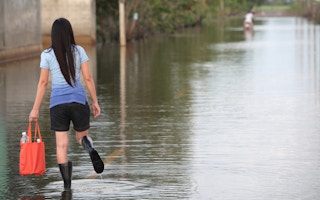US Secretary of State John Kerry last week turned the spotlight on the “record number” of extreme weather-related events the world is witnessing these days.
With an eye on the upcoming climate change talks in Paris, he warned that in the South Pacific, entire islands are at risk, largely threatened by a sea-level rise.
In southeast Brazil, they’re suffering through the worst drought in 80 years. In California, it’s the worst drought in a century – plus wildfires.
In Malawi, there are record floods. And in the Arctic, whole villages are in danger, said Kerry, speaking at the Indiana University’s School of Global and International Studies on Oct.15.
Despite Kerry’s admonition, the role of water remains a relatively neglected issue in the run-up to the Paris talks, while the primary focus has been on carbon emissions.
Reinforcing the need for water security, Louise Whiting, Senior Policy Analyst on Water Security & Climate Change at UK-based WaterAid, told IPS the world’s poorest are affected most by climate change, which is felt primarily through water: too much (flooding and rising sea levels), too little (droughts), at the wrong time (unpredictable weather patterns) or of the wrong quality (too salty or polluted).
The more than 650 million poor and marginalised people who rely on unsafe water sources will be increasingly vulnerable as these sources are highly exposed to climate-related threats.
For example, she pointed out, floods can inundate tube-wells, and natural sources of fresh water can become contaminated with salty seawater.
And in the lead-up to this year’s UN climate talks from Nov 30 to Dec. 11 in Paris, WaterAid is calling on the international community to make water security, which includes first and foremost having access to water, sanitation and hygiene, a priority when it comes to helping poor countries adapt to climate change.
Whiting said adequate water, sanitation and hygiene facilities improve people’s health, education and economic stability, making them more resilient to climate change.
‘We must also ensure that money flows from the people that caused the problem to those least able to cope with it.”
In 2010, the UN General Assembly voted on a resolution that recognized water and sanitation as a human right.
And UN Secretary General Ban Ki-moon has repeatedly said that safe drinking water and adequate sanitation are crucial for poverty reduction, crucial for sustainable development and crucial for achieving any and every one of the Millennium Development Goals, which end December.
But the 17 new Sustainable Development Goals (SDGs) adopted by world leaders on Sep. 25, also singles out water and sanitation as key issues in the UN’s post-2015 development agenda.
By 2030, the United Nations is hoping to achieve universal and equitable access to safe and affordable drinking water for all; improve water quality by reducing pollution, eliminating dumping and minimizing release of hazardous chemicals and materials; and substantially increasing water-use efficiency across all sectors and ensure sustainable withdrawals and supply of freshwater to address water scarcity, and substantially reduce the number of people suffering from water scarcity.
Whiting told IPS WaterAid will be focusing on improving access to safe water and a decent toilet for poor communities.
“Through our work we increase water storage capacity and strengthen monitoring of water supplies so droughts can be detected early. Where flooding is a problem, for example in Bangladesh, we make infrastructure more robust where necessary, and we also help communities come together and assess their own vulnerability so they can demand better services from their governments”
WaterAid is also helping 29 communities across West Africa cope with water scarcity and becoming more resilient to climatic threats, particularly by helping them improve the way they manage their own water resources.
In Burkina Faso, where the dry season already lasts for up to eight months a year, many communities live a precarious existence. Climate change will only exacerbate their situation.
WaterAid is combining additional boreholes, sand dams and improvements to existing wells alongside training local people to become water experts.
These experts, she said, are revolutionising communities’ abilities to control their own water supply by measuring water levels, monitoring rainfall, pre-empting threats and spotting emerging data patterns, so they know what water can be used, at what times of day, and in what quantities.
They are also feeding that data into government monitoring schemes, to help build a more cohesive national picture of climate patterns across the country.
“Nature doesn’t care whether you are a poor subsistence farmer in Burkina Faso or an accountant in California,” Whiting said.
“Climate change will impact us all. However, it will impact those who have contributed the least to the problem the hardest.”
World leaders gathering in Paris must commit to providing the technical and financial support that is needed to help poor countries adapt to the coming changes, she declared.
According to the United Nations, about 2.6 billion people have gained access to improved drinking water sources since 1990, but 663 million people are still without, and at least 1.8 billion people globally use a source of drinking water that is fecally contaminated.
Between 1990 and 2015, the proportion of the global population using an improved drinking water source has increased from 76 per cent to 91 per cent.
The UN also points out that water scarcity affects more than 40 per cent of the global population and is projected to rise.








